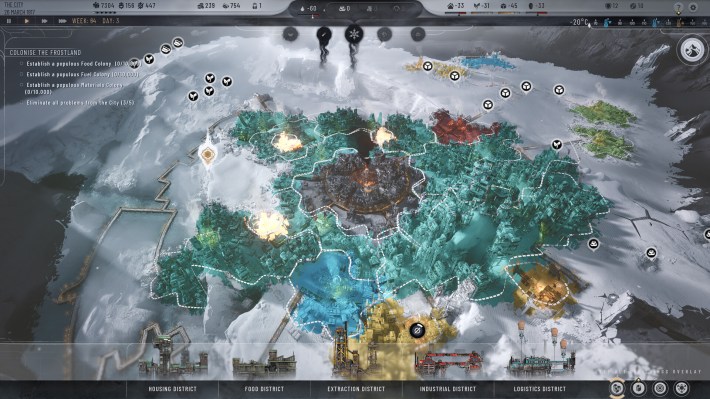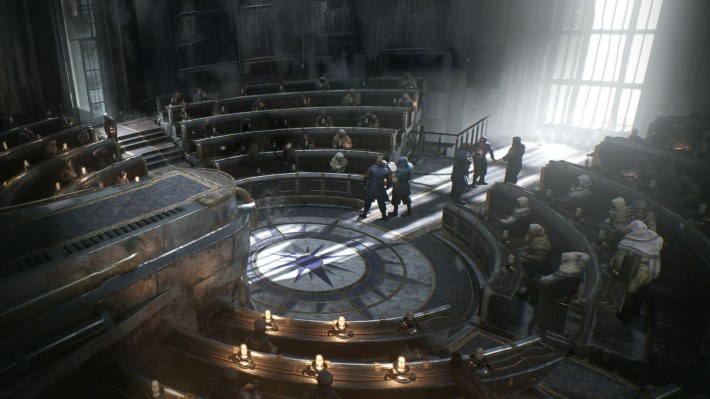I’m just starting Chapter 3 of Frostpunk 2’s story mode, but I already want to start the whole game over. It’s the curse of city-builders, or at least when I play them: learning more as you go and realizing how much better things could be if only you’d done something different further back, realizing the ways you’ve hamstrung your little civilization by building on shoddy foundations. But I’m too attached to my version of New London–all its demanding people, and its struggling satellite towns, and the direction my whole society is moving in– to turn back now.
Frostpunk 2 comes out Friday for PC, and later for consoles, but people who preordered can play it today. It’s a sequel to 11 bit studio’s 2018 wintery, steampunk city-builder, where you created a circular city around a vital, heat-giving generator, and then dealt with all your tiny citizens being pissed off at everything you did afterwards. The sequel does away with the circle and the clustered city, leaning into a hex-based sprawl that extends into the iced-over wastelands outside your city too.
While I miss the spatial constraints of the first game, I appreciate what Frostpunk 2 is doing with its new shape. It feels like it wants to be a bigger game in every way, asking you to think about civilization as a whole. In terms of city planning, you first have to “frostbreak” a required number of hexes before you can build on them, and then instead of constructing buildings you construct entire districts. These districts have specific functions: extracting necessary items like materials, food, coal, or oil; industrial areas that can produce goods, needed to keep people happy and crime down, or prefabs, which are required for building; housing for your rapidly growing population; or logistics areas that create scouts to explore the snowy frostlands beyond. I found frostbreaking a little annoying, feeling like an extra step and cost, but it embodies the vibe of effort that defines the game. The snow isn’t just for aesthetics here; of course you’d have to break the ice before you could build.
This grander physical scale also means a more zoomed-out, complicated experience. Time moves in weeks instead of days, and districts require huge amounts of workers to function, requiring massive populations that come with the downside of requiring more resources. Things feel less intimate than in the first game, and while individual citizens still pop up with stories to tell and requests to make, I found myself thinking about them more as numbers, like any other resource. Instead of managing a little city, you’re managing an entire civilization, and the unique people within it started to fade into the back of my brain in favor of focusing on my need for more space and more resources.

Your local resources will eventually run out, requiring expanding into the outlying areas, setting up new mini-civilizations and connecting them to your main city via trails or higher-capacity skyways. In the story mode’s prologue, you have to get a generator in an old train up and running; later in the story, you return to create a colony that can extract oil to send back to your main city of New London. I did terribly by these isolated, necessary colonists, putting them on extra shifts pumping oil and then shipping all of it away to heat my main city and provide resources for other outposts or settlements. (There are three different names for the outlying areas you can set up; suffice it to say they have different levels of management required, and are differently affected by weather events.) When workers died during emergency shifts, I just sent more workers, creating housing and food shortages. At one point, a group of nomads demanded the colony stockpile oil for them, but I just kept sending that oil away because the city needed it more, leading to a slaughter that at least solved my resource shortages. When a whiteout weather event set in, interrupting the flow of resources and creating a crisis in New London, I basically abandoned the little oil colony completely to focus on the city. I returned to just a handful of survivors, and am now faced with getting the whole thing back up and running on top of my guilt.
In one way, I really like this mechanic: juggling so many moving pieces and competing needs, zooming in and out to make sure my whole system is working. In another way, it felt a little busy at times. I had to fiddle with a lot of moving resources around to supply or upgrade areas: my oil colony had its own economy, but to get needed oil to my food-producing settlement, I had to send it from the colony to the city first, and this is just one minor example of all the resource moving and balancing and stockpiling the game requires. It all feels engagingly hands-on, but also a little bit complicated for the sake of being complicated. Whether this is a good or bad thing is down to your personal tastes, but I admire that the sequel is more than just a rehash. It stays true to the original’s focus on balancing competing demands, but expands that out into every aspect of the game in a way that gives you both more demands to balance and more control over how you do so.
There is, of course, still a focus on people, one of the notable qualities of the first game. Here, there’s a whole council to wrangle with, full of communities and factions with their own worldviews, goals, and opinions on your leadership. You’ll need to get enough of them on your side to pass the laws you want to pass and shape your city to your whims. Early on, my delinquent youth were causing crime; my options were to institute mandatory schooling, supported by the forward-thinking Evolvers faction, or mandatory apprenticeships, supported by the traditionalist Faithkeeper faction. Each of these groups had their minds made up, which left my two communities, the New Londoners and Frostlanders, somewhere in the middle. (As with the outlying areas above, there are different kinds of groups of people: factions arise from communities and have more opinions, and will hold rallies or take aggressive actions on their own.) To sway those undecided delegates to my choice, I could promise them things: offering to build the Frostlanders a survivalist headquarters (makes them happy; decreases my exploration time), or pass a law about machine-centric work shifts that would please the New Londoners (making districts require less workers; increasing squalor and thus wear on my districts). Or, I could avoid negotiating altogether by just holding the vote and seeing how things panned out.

The council feature’s bigger, more complicated take on the first game’s moral choices is a lot of fun, asking you to balance your goals with the demands of different groups of people and do a certain bit of manipulating to get what you want. You can fail your promises, accidentally or on purpose, turning groups against you and sowing distrust, too much of which will end your game. You can also micromanage these relationships a great deal, giving or taking money from groups, letting them choose what laws you vote on, or letting them take special actions. Factions and communities give your civilization a grand, messy personality that I felt like part of more than its commander; when I started, I wanted to side with the Faithkeepers, but the city kept going in the direction of the Evolvers because they kept bringing me useful demands and innovations. Where I sometimes didn’t love how many new pieces the expanded city-building has, I was delighted by all of the politicking and voting and micromanaging of the human side of things, down to the lovely council chambers graphic and all its mumbling, cheering members.
You’ll notice all the little distinctions and explanations I bracketed out above, like the differences between factions and communities, or outposts, settlements, and colonies. Frostpunk 2’s bigger scale introduces what I found to be sometimes too much complexity, especially in my first time through the game. There’s a hefty text tutorial that, while helpful as a constant reference, didn’t always feel like it was introduced to me at the right time. I should be very clear that some of this is surely down to my own lifelong struggle to be patient during tutorials, and that the onboarding might have changed by the game’s final release. You’ll also benefit from guides and videos; in a couple instances where I watched people’s playthroughs of the game’s open beta, things were much easier for me to understand when I saw them in action. Some of my confusion might also be down to the game’s new perspective: a bigger city and more things to manage makes it easier to lose track of certain specifics, and while the game does a good job of using icons to show you where something’s gone wrong, it can take a bit of poking in tooltips and submenus to understand exactly why, and sometimes tweaks to your whole system to fix. Combined with a whole new lexicon and every building action’s various resource requirements (I haven’t even touched on the money-like heatstamps and how you get them, or the findable cores required for certain upgrades, or the research tree), Frostpunk 2 has a lot going on. Sometimes this felt like it made my experience better, but other times it felt like it just made my experience more.

While the story mode’s fail states don’t make it a great learning environment in some ways, it does help you figure out how to deal with and prioritize the things you’ll face in its open game mode. Moments of feeling frustrated or overwhelmed were balanced by learning more about why the game’s many pieces mattered as I clumsily banged them together and saw what the outcomes were. The more I played, the more I could see the possibilities behind the things that confused or overwhelmed me on their first introduction. Like many city-builders, and like the first game, it feels like one where you’ll want to embrace failure as a learning experience, and where mastering what it’s doing will give you a ton of control to experiment and roleplay. I’m excited to improve at it, and to learn from and be inspired by what other players do. I am bravely resisting the urge to nuke my starter city because I’m not the player–or city leader–I was when I started; this sense of growing control feels like I’m improving as a leader alongside my civilization’s improvements.
Frostpunk 2 isn’t just more Frostpunk, something I would have been happy with. It’s bigger and more complicated and more demanding and more personalizable in every aspect, all while staying true to the heart and ethos of the first game. That’s no small feat, and it’s exciting to see in a sequel. It's a game that knows what it wants to talk about and what it wants you to play with. Even when I felt like I had way too much to do, the way any beleaguered city leader might, I was excited to come back for more.


